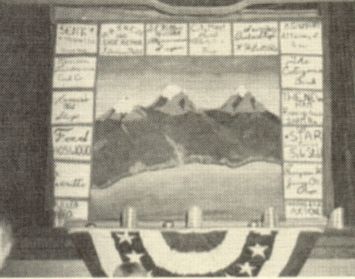SILENT MOVIES AND THEATRE
by Claudia Tompkins
Entry T70 from the History of Hooker County Nebraska
with permission of the Hooker County Historical Society

Duplicate of the Opera House Drop Curtain for silent
movies in the early 20's Picture of Duplicate 1956
Silent movies, just as the term signifies, are
movies that portray the story and conversa-
tion or explanation in black and white. There
is no background music or sound, perhaps
someone reading the captions or conversa-
tions aloud might be heard. There were silent
movies shown in Mullen in 1917. In August
of 1918, work began on a new building for
picture shows.
The Hooker County Tribune dated Jan-
uary 10, 1919, quoted "The first show in
Mullen's new play house was given to the
audience last Saturday afternoon and eve-
ning, without money and without price. It
was a treat from the management, Mr.
Hawley and Mr. Soreson, it was their way to
start the ball rolling for a 3 times a week
program, Monday, Wednesday and Satur-
day, that will be given the public during the
long winter evenings. The bookings will be
given to the public as fast as they are
arranged for."
A few months later it was decided to have
shows on Tuesday nights, also. Some of these
silent movies would have as many as seven
reels. When one reel was finished, the
audience visited while the next reel was being
prepared for showing. One of the shows being
advertised at this time was entitled Reaching
for the Moon starring Doug Fairbanks. The
ad also stated that a Liberty Loan Reel,
Official War Review would conclude the
entertainment, there had been a band con-
cert before the show had begun. (Read
Roseberry Building for details on the silent
movies.) The Keeper Of The Bees - Gene
Stratton Porter was popular, Robert Frasier,
Clara Bow, Alyce Mills were stars; 25 cents and
50 cents admission.
The first `talkies' were booked and brought
to Mullen to be shown in Senk's Theatre or
as some still called it the `Roseberry Build-
ing'. The first talkie movie was titled The
Vagabond Lover starring Rudy Valee. Many
citizens of the Mullen community will re-
member this exciting day in June, 1930 when
they stood in line to climb the stairs to the
theatre, to see and hear a movie on the screen.
Another double feature in 1930, October 22
and 23rd, was George Washington Slept
Here with Jack Benny and Ann Sheridan,
and Desperate Journey with Errol Flynn
and Ronald Reagan.
In the year 1947, J.E. "Butch" Macke
bought the building that now houses the B.D.
Enterprises, from Walter and Florence Bar-
nebey. (This building had been built by the
Barnebey's to install the telephone switch
board.) This building was 60' long and Macke
purchased 36' more of ground from Carl
Humphrey to make the building overall 96'
long. The projector was 82' from the 16' x 20'
screen, in front. J.E. and Mrs. Macke man-
aged the theatre for 15 years until Luther
Phipps purchased it. Mr. and Mrs. Cliff
Stahely managed the show business for two
years. Mr. Phipps then sold the theatre
business back to the Mackes. The Mackes
contracted and booked only the top quality
films to show in Mullen. One of the favorites
was Rawhide starring Tyrone Power, Susan
Hayward, H. Marlowe and Dean Jager.
The big News reels were now available also
and the Mackes advertised that the news was
as good as you might see in Omaha or any
other city. Many people attended the shows
to see the latest in news as much as to see the
main attraction.
In October of 1967, a notice was put in the
local paper that the Theatre would be closing
because of too many empty seats. This was
due to so many school activities and other
community affairs, that the theatre atten-
dance was so small that the price of the films
could not be met with the door admittance.
There has been no theatre business in Mullen
since.
There was a group of Mullen Players that
would put on plays from time to time. A
comedy 3-act play was presented to the
public, Ace High which was sponsored by the
Woman's Welfare Club in the Senk Theatre.
Another entertainment which came for
several years was the "Plunketts" Stage
Show and Circus combined. This was always
exciting and drew great crowds, for two
nights at least under the tent.
Chautauquas were very popular for enter-
tainment. The performances were held under
a huge tent with lots of music, comedy, acts,
etc. These shows were very popular in the
20's. They usually were performing for three
or four days.
